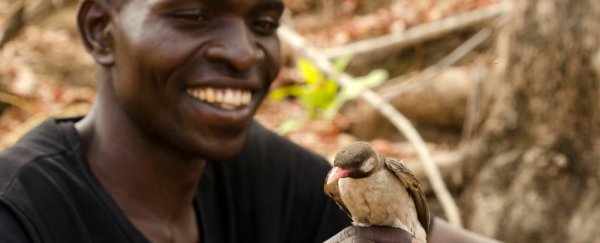Zoologists have documented an incredible relationship between wild birds in Mozambique and the local Yao people, who team up together to hunt for honey.
Using a series of special hails and chirps the humans and birds are able to communicate - honeyguide birds lead the way to hidden beehives, where the Yao people share the spoils with their avian friends.
It's a beautiful mutualistic relationship that's been known for more than 500 years - but now, for the first time, a team of researchers from the UK and South Africa have shown that the honeyguide birds and humans are actually communicating both ways in order to get the most benefit out of their collaboration.
While it's not uncommon for us to be able to communicate with pet birds and other domesticated animals, it's incredibly rare for humans to be able to 'speak' to wild animals - and even rarer for them to be able to speak back voluntarily.
Even more impressive, no one's ever trained these birds. They're choosing to collaborate with the humans on their own.
"What's remarkable about the honeyguide-human relationship is that it involves free-living wild animals whose interactions with humans have probably evolved through natural selection, probably over the course of hundreds of thousands of years," said lead researcher Claire Spottiswoode, a specialist in bird behaviour from the University of Cambridge and the University of Cape Town.
The honeyguide bird (Indicator indicator) is found widely across sub-Saharan Africa, and a number of different communities have been documented collaborating with the wild birds to get them to look for hidden bees' nests high up in trees.
The birds love to eat the wax combs inside these bee hives, but they can't crack them open by themselves - and risk being stung by honeybees in the process. So they enlist the help of humans, who smoke out the bees and crack open the nests, taking the honey and leaving the wax combs behind for the birds to feast on.
According to previous studies, the relationship works both ways - sometimes the birds spy a beehive on their own and quickly find a nearby human, using a signature chirp to get their attention.
And sometimes a honey-hunter from the Yao community will solicit the help of a nearby honeyguide bird when they feeling like heading out, using their own unique birdcall to attract a willing bird.
This bird call, which you can hear below, has been passed down from generation to generation, and sounds something like a "brr-hm".
Although this beautiful relationship has been well documented, Spottiswoode wanted to figure out once and for all whether the humans and birds were purposefully working together, and whether these "brr-hm" calls the Yao people were making actually made a difference.
To do this, she worked with members of the Yao community and asked them to go and hunt for honey, but to play three different automated noises as they did so: the "brr-hm" call, a random word in the Yao language, or an unrelated bird call.
One of these three calls was played every 7 seconds on a handheld speaker at the same volume as the honey hunters walked around looking for a hive. And the results were pretty striking.
"The traditional 'brrr-hm' call increased the probability of being guided by a honeyguide from 33 percent to 66 percent, and the overall probability of being shown a bees' nest from 16 percent to 54 percent compared to the control sounds," said Spottiswoode.
"In other words, the 'brrr-hm' call more than tripled the chances of a successful interaction, yielding honey for the humans and wax for the bird."
Publishing their research in Science, Spottiswoode and her team conclude that this is a clear sign of conscious communication between the birds and the human honey hunters.
"These results show that a wild animal correctly attaches meaning and responds appropriately to a human signal of recruitment toward cooperative foraging … a behaviour previously associated with only domestic animals, such as dogs," the team writes.
According to the researchers, the only other known cooperative relationship between wild animals and humans in the world is the one that exists between local fishermen and dolphins in Brazil - where dolphins have been seen being called upon to herd schools of fish towards fishermen.
Spottiswoode is now fascinated to learn more about how this collaborative relationship evolved, and how it's passed down.
It's a little complicated, because the honeyguide is similar to a cuckoo, in that it lays its eggs in the nests of other birds and the chick is raised by a different species - so that means its parents can't be teaching it the specialised calls.
The human side of the relationship is a little easier - the "brr-hm" call has been passed down by fathers in the Yao community for as long as anyone can remember.
"Intriguingly, people in other parts of Africa use very different sounds for the same purpose - for example, our colleague Brian Wood's work has shown that Hadza honey-hunters in Tanzania make a melodious whistling sound to recruit honeyguides," said Spottiswoode.
"We'd love to know whether honeyguides have learnt this language-like variation in human signals across Africa, allowing them to recognise good collaborators among the local people living alongside them," she added.
